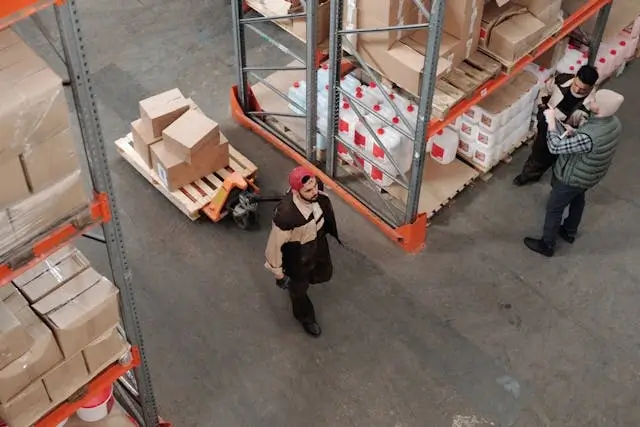

- BLOG
Which Cities in the US had the Worst Traffic in 2025?
Published: April 1, 2024 | Updated: July 14, 2025
Route Optimization API
Optimize routing, task allocation and dispatch
Distance Matrix API
Calculate accurate ETAs, distances and directions
Directions API
Compute routes between two locations
Driver Assignment API
Assign the best driver for every order
Routing & Dispatch App
Plan optimized routes with 50+ Constraints
Product Demos
See NextBillion.ai APIs & SDKs In action
AI Route Optimization
Learns from Your Fleet’s Past Performance
Platform Overview
Learn about how Nextbillion.ai's platform is designed
Road Editor App
Private Routing Preferences For Custom Routing
On-Premise Deployments
Take Full Control of Your Maps and Routing
Trucking
Get regulation-compliant truck routes
Fleet Management
Solve fleet tracking, routing and navigation
Middle Mile Delivery
Optimized supply chain routes
Construction
Routes for Construction Material Delivery
Oil & Gas
Safe & Compliant Routing
Food & Beverage
Plan deliveries of refrigerated goods with regular shipments
Table of Contents

Traffic conditions have a direct impact on the growth of the country. Better traffic conditions contribute to the overall growth of the country; however, vice versa is also true. Nobody likes the experience of sitting bumper-to-bumper and simply feeling stuck with nothing you can do about it. People tend to avoid heavy traffic by timing their commute to avoid rush hours and planning alternative routes, etc.
Moreover, traffic congestion is caused by multiple factors, such as the availability of public transportation options, the volume of cars and trucks on the road, the road grid, and the density of the environment in terms of residents, businesses, and population attractions.
Traffic congestion continues to plague numerous U.S. cities in 2024, causing significant delays, increasing travel times, and contributing to higher levels of commuter frustration. Based on recent rankings, we’ve compiled the top 25 U.S. cities with the worst traffic conditions. These cities have been ranked by average travel time per 10 kilometers, congestion levels, and the time lost annually in rush hours. Here’s a detailed breakdown:
These 25 U.S. cities experience the worst traffic conditions in 2024. From extended travel times to significant hours lost in rush hour congestion, drivers in these cities face daily challenges that impact productivity and quality of life. Managing traffic in urban areas remains a pressing issue, highlighting the need for advanced solutions to ease congestion and improve traffic flow.
While traffic congestion is a common problem in many major cities, some cities in the United States have managed to maintain relatively smooth traffic flow. In 2024, several U.S. cities stand out for their low congestion levels, faster average speeds, and minimal time lost during rush hours. Here are the top 10 cities with the least traffic congestion based on key metrics like average travel time, congestion level, and time lost in rush hour:
These cities have the least traffic congestion in the United States in 2024, offering smoother commutes and less time spent in traffic. With low congestion levels and fast average speeds, residents in these areas benefit from more efficient roadways, even during peak travel times. These cities are examples of effective traffic management and infrastructure that help minimize congestion.
The major key causes of congestion are:
Traffic congestion-related delays are major pain points in the logistics industry. At a minuscule level, logistics giant UPS suffers an additional operating cost of $105 million yearly for just a five-minute delay in traffic. Below are its negative impacts:
Traffic congestion can significantly impact logistics operations, leading to delays, increased fuel consumption, and higher operational costs. Overcoming these challenges requires more than just monitoring traffic conditions; it demands advanced route planning, real-time traffic data, and flexible routing solutions. Leveraging technologies like NextBillion.ai’s Directions and Matrix APIs can help logistics companies optimize their routes, minimize delays, and improve efficiency.
Here’s how:
Congestion in urban areas can slow down delivery times and reduce overall logistics efficiency. NextBillion.ai’s Distance Matrix API enables companies to analyze traffic flows within a city by estimating transit durations and distances between thousands of origin and destination points. The Matrix API can handle large datasets, processing up to 5000×5000 matrix size in a single request, which is invaluable for logistics companies managing high order volumes across multiple locations.
With real-time ETAs and distance calculations, logistics managers can reroute deliveries to avoid congested areas and ensure on-time arrivals. This capability allows companies to make data-driven decisions that improve route planning and fleet management, ultimately leading to faster deliveries.
NextBillion.ai’s APIs use pre-processed map data, which provides faster transit estimates. By calculating distances and ETAs in just a few seconds, companies can quickly adapt their routes to changing traffic conditions. This is especially useful when handling time-sensitive deliveries in congested cities. Fast and accurate traffic data allows for dynamic rerouting, ensuring that deliveries are made on time even during peak traffic hours.
Logistics operations often involve a variety of vehicles, including trucks that have specific route requirements due to their size and weight. The Directions Flexible API allows logistics companies to plan routes with truck-specific parameters. By specifying vehicle dimensions and mode of transport, companies can avoid roads that are unsuitable for trucks or subject to vehicle restrictions. This feature ensures that trucks can navigate the city efficiently while adhering to local regulations.
Additionally, the Directions Flexible API factors in real-time traffic conditions and offers route customization options. Companies can choose between the fastest or shortest routes depending on the delivery priorities and receive segment-wise speed limits to optimize their driving strategy.
Congestion can lead to unexpected delays, especially if it isn’t accounted for in the route planning process. NextBillion.ai’s Directions API integrates real-time traffic data, enabling logistics companies to calculate traffic-aware ETAs and avoid congested routes. This reduces the risk of on-road surprises and helps delivery vehicles bypass traffic bottlenecks.
By using this API, logistic operations can proactively manage traffic disruptions, ensuring that drivers take the most efficient routes based on current traffic conditions.
For logistics companies operating in cities with complex traffic patterns, route restrictions can significantly affect travel times. The Directions Flexible API allows companies to apply custom route restrictions to their maps, such as avoiding tolls, ferries, or u-turns. This helps in generating realistic ETAs and distances, providing more accurate delivery timelines.
For example, if a company knows that certain roads are closed or heavily congested during specific hours, they can use these restrictions to avoid those routes automatically. This flexibility allows logistics managers to plan routes that minimize disruptions and ensure smoother deliveries.
For logistics companies managing multiple deliveries across a large network, the Asynchronous Distance Matrix API is a powerful tool. This API computes distances and ETAs between a large set of origins and destinations, making it perfect for one-to-many or many-to-many delivery scenarios. The asynchronous nature of the API allows users to submit large sets of coordinates and retrieve results later, enabling logistics managers to process vast amounts of data without delay.
This API is particularly useful for fleet managers who need to plan multiple deliveries simultaneously, ensuring that each route is optimized for speed and efficiency.
Here are some strategies that help to overcome traffic congestion and speed up the logistics operation:
Moreover, NextBillion.ai’s Road Editor tool is a game changer in overcoming traffic congestion problems. It precisely reflects the road closure, restrictions, speed limits, and permits on the selected route. The fleet operators can utilize this tool to update the underlying road network data to reflect upcoming restrictions based on vehicle type, permissions, time of day, etc.
Shivangi is a seasoned Technical Writer with a passion for simplifying technical concepts. With over 5 years of experience, she specializes in crafting clear and concise documentation for various technical products and platforms.